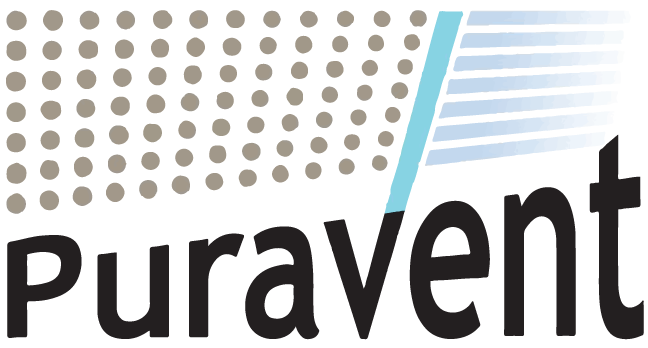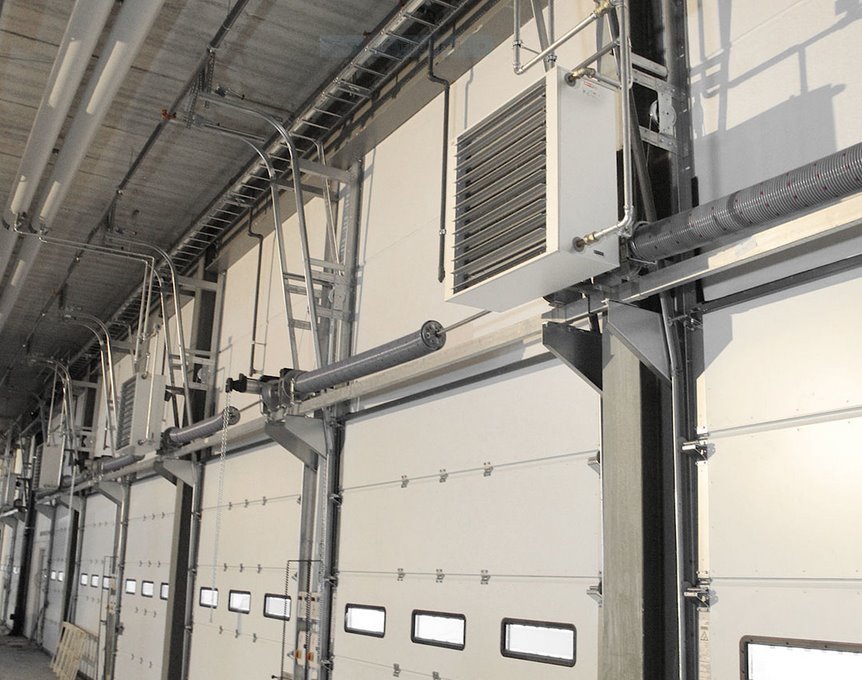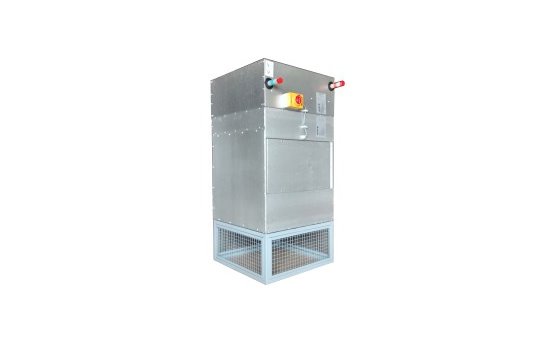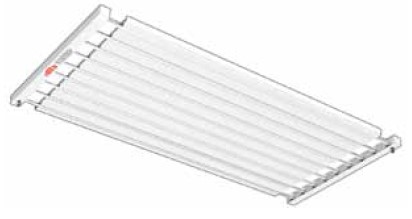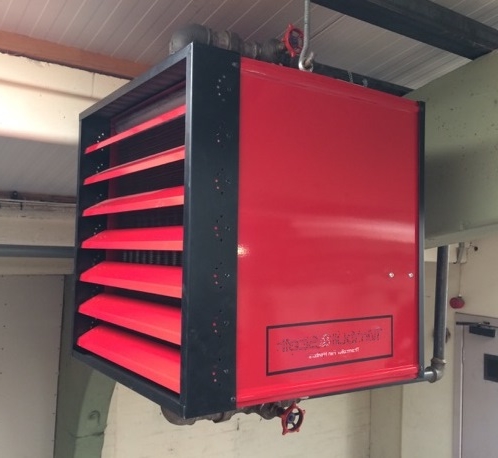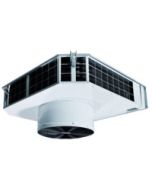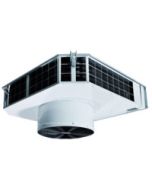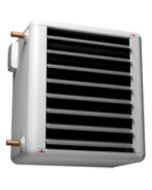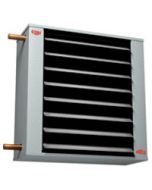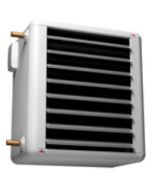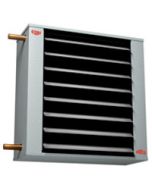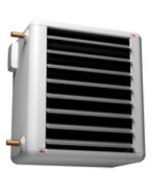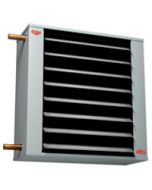Many industrial buildings prefer to run their heating from a piped hot water circuit or from piped steam. Where heat is available in this form then it is invariably the most cost effective method of space heating a room or building. As with electric fan heaters, there are a variety of types and options available and we aim to make choosing the right model as easy as possible. The following guidance is written around the product ranges that we supply namely;
Applications for Water and Steam Fed Fan Heaters
There is no doubt that if you have a good source of heated water on a piped circuit then these fan heaters are a very cost effective way to discharge the heat in to the areas in which it is needed. Also each model has a large range of heat output depending on the flow temperature, return temperature, ambient air temperature, and water flow rate. This means that with the addition of a recirculation air / fresh air mixer cabinet and suitable controls, the SWS and SWH ranges are an ideal compliment to heat sources that are bit less controllable than straight oil gas or electricity fired systems. For biomass boilers, solar fed thermal stores and wind turbine heated thermal stores it is useful to have not only a quick and effective means of dumping excess heat, but also a system that can deliver heat from quite low temperatures and be easy to integrate with a secondary heating system when water temperature is too low.
Space Heaters - How much Output?
If you are using a water or steam fed heater to space heat a room, the implication is that you are using available surplus heat and this will be the principle heating for the room. By contrast electric fan heaters are often secondary heating sources. As with any heating requirement the initial stage is to identify the size of the heating requirement. If it is a room you want to heat then then this is fairly straight forward; just use our calculator tool.
The space heater calculator provides approximate heating requirements for several generic building types, which for most users is accurate enough. For accurate heat loss calculations you would need work it out from scratch using the U values of the various materials that are used to make your room or building. Bare in mind the heat contribution that might be made by other heating in the room, whether it is from a heating system or perhaps from a hot industrial process or machine. If it is a variety of rooms, in other words the heater will be used in several different places, then try to select the largest amount of power that you may need.
Configuration for water fed fan heaters
It is seldom the case that a required heat output for a system of water or steam based fan heaters can be met neatly with a single heater. In most cases there are a number of configurations using a number of models from a range to achieve the overall space heating requirement for an application. Sometimes there is a choice between a number of heaters of a large size or a greater number of heaters at a smaller size.
Generally the smaller number of larger heaters will be more cost effective in terms of heater cost, control costs and installation cost. But the choice of heater should also take into consideration the shape of the room and air throw of heaters, perhaps using larger heaters for larger uniform areas, and using smaller units for heating smaller dead areas of the main area.
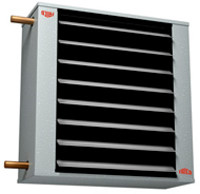 | 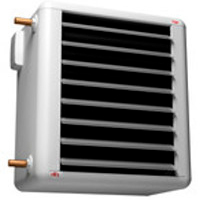 |
| Frico SWS water fed fan heater | |
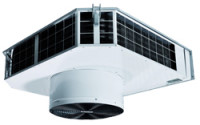 | 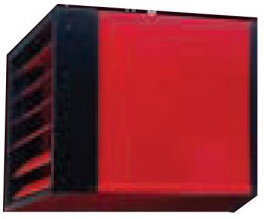 |
| Thermolier Steam fed fan heater | |
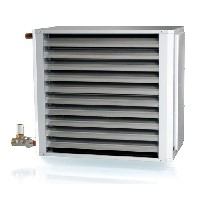 | 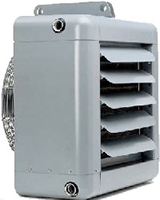 |
| VEAB AW LPHW unit heater | Cirrus Unit Heater |
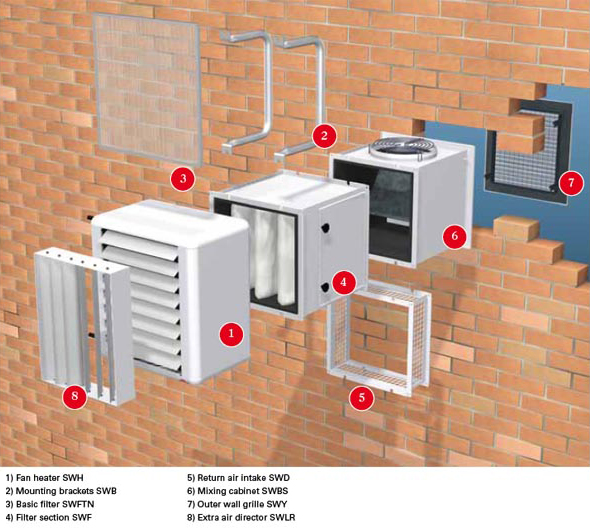 |
Because the water fed heaters usually use a circuit of hot water that is often 'surplus' it is quite common that these heaters are not merely mounted on wall brackets, in 100% recirculation mode, but mounted on mixer boxes, which themselves are mounted over a vent in the outside wall, enabling heated air to be a mixture of recirculated and fresh air.
With the addition of either manual or motorised dampers, the mixer boxes allow a the flow to through the heater to be set at any level from 100% fresh to 100% recirculated and anywhere in between.
Mixer boxes are useful because in addition to being able to take air straight from the room through a grill, the grill can be removed leaving a upstand (spigot) for ducting connection, so that the mixing box can be part of a more complex ducted ventilation system.
The key element to connection to a mixing box where outside air is brought in, is that the heater control system incorporates frost protection functionality, to prevent any chance of water freezing in the coils when the heater coils are not being used for general heating.
As well as mixer box options, there are also filter box options allowing a G3 efficiency filter to be fitted. This fitting is essential if the fan heaters are to be used in dusty environments in order that build up of dust on the coils is prevented.
Mounting And Connection of Water Fed Fan Heaters
The water fed fan heaters that we supply can all be installed for right hand or left hand connections. The heater is merely rotated 180 degrees to switch the connections from one side to the other. The convention is that inlet is the uppermost connection. Connections can be made either with compression fittings or as plain soldered joints.
|
If filter boxes or mixer boxes are to be used then the heaters would inevitably be wall mounted where the heat distribution is horizontal, however where there is a need to mount from the ceiling, then this can be accommodated using the mount brackets fitted to the back of the heater housing.
 |
This then enables the heater to be mounted to the ceiling from vertical steels for and the water connections can be on either side, or on top for vertical air distribution. The capability for ceiling mounting is especially important to enable even heat distribution in larger buildings.
While the various water fed fan heaters that we supply are usually used for wall mounting, but with the capability of ceiling mounting where required, there is also a separate product range, SWT, of dedicated ceiling mounted water fed fan heaters, which can be all of, or part of, an array of heating fan coils for larger buildings. The difference with SWT is that the the heated air is discharged in a vertical column from the heater. With its ceiling mounting and downwards discharge of warm air it means that these heaters also destratify the air as well as heat it so that separate destratification fans are not needed. The SWT is also available with accessories including inlet filter screens, which prolong the coil cleaning service interval, discharge extension collar, which increases the air throw of the unit, and a louver fitting, which distributes air to the sides rather than straight down.
Heat source for Water fed Fan Heaters
Whilst many will consider conventional boilers to be the heat source of choice for a hot water circuit, they are not necessarily the most flexible source of heat. Water fed fan heaters are not fussy about what heats the water up and will operate perfectly well from a wide range of water feed temperatures. The SWS and SWH heaters that we supply can work with fed temperature anywhere in the range 60 - 125°C and at pressures up to 10 bar. This means that as well as being ideally suited to conventional large boilers, the units can also use relatively low grade heat produced by chiller/heatpump/ boiler combinations, where the chiller or heat pump preheats water to say 40-50°C before the boiler adds top temperature to get it to normal heating circuit flow of say 80°C. The benefit of this type of arrangement is that typically the winter heating costs are lower and that in summer the chiller can be used to cool water for the heating circuit. Even if you have a heatpump or chiller producing 60°C this is hot enough to be used to feed LPHW fan heaters, the only difference being that you will get fewer kilowatts out of it than if the flow temperature was higher. The beauty of LPHW fan heaters is that even for lower temperature flows, they are still a very cost effective way of discharging heat.
Cooling From A Fan Heater?
Often overlooked when choosing whether or not to use mixer boxes as part of the installation, is their usefulness in summer. Industrial buildings particularly those with steel skinned cladding and or heat producing processes can become uncomfortably warm in summer. With mixer boxes behind your fan heaters you can set the box to 100% fresh to draw in relatively cool fresh air to displace warmer air in the building through the various external doors.
If the heaters depend in part on a chiller for the heat generation, then in summer months this can be used as a cold water source so that the 'heaters' can be used for cooling the air.
Controls for Fan Heaters
The control of water and steam fed fan heaters make a simple heater into a sophisticated heating system. To consider each of the heater ranges in turn;
Frico SWS water fed fan heater
SWS is only designed to operate with, a relatively simple control system.
| Airflow Control | Thermostatic Water flow control | |
| 230v models | 5 step control by RE series (exact model dependant on amperage loading) | 2 way valve and actuator, with either a T series thermostat or a KRT capillary tube thermostat |
| 415v 3 ph models | 2 step control by SWYD1 controller and STDT16 thermal contact motor protection | 2 way valve and actuator, with either a T series thermostat or a KRT capillary tube thermostat |
Frico SWH water fed fan heater
SWH is a far more sophisticated water fed fan heater, because its control options have a larger variety of functions. The heater unit itself comes equipped with the control option module that you choose.
| Control Module | Control functionality | Water flow control | ||||||||||||||||||||
| SIReB Basic |
| VOS valve kit on/off comprising;
or a, VOSP pressure independent valve kit on/off, comprising;
| ||||||||||||||||||||
| SIReFC Competent |
| VOS valve kit on/off comprising;
or a, VOSP pressure independent valve kit on/off, comprising;
| ||||||||||||||||||||
| SIReFA Advanced |
Also there is a variation on the above which is to have a SIReFA WM which also provides automatic control of heating and ventilation using an upstream mixing cabinet | VMO Modulating valve kit, comprising
or a,
|
Frico SWT water fed fan heater
SWT is only designed to operate with, a relatively simple control system from the following options;
| Control Method | Unit Control | Water flow control |
| Thermostat only The thermostat starts/stops the fan and also controls the heat supply on/off. The fan is set to run on high speed | KRT1900 or T10/TK10 room thermostat | TVV20/25, valve + SD20, acutator |
| 2 step airflow control The air flow is manually regulated in 2 steps. No heat regulation, maximum water flow through the heating coil. | CB20, control panel | Nil |
| 2 step airflow control and thermostat The thermostat starts/stops the fan and also controls the heat supply on/off. The air flow is manually regulated in 2 steps. | CB20, control panel
| TVV20/25, valve + SD20, actuator |
| 5 step airflow control The air flow is manually regulated in 5 steps. No heat regulation, maximum water flow through the heating coil. | 5 step control by RE series (exact model dependant on amperage loading) | Nil |
| 5 step airflow control and thermostat The thermostat starts/stops the fan and also controls the heat supply on/off. The air flow is manually regulated in 5 steps. | 5 step control by RE series (exact model dependant on amperage loading) KRT1900 or T10/TK10 room thermostat | TVV20/25, 2-way valve or TRV20/25 3-way valve + SD20, actuator |
VEAB AW unit heaters
This range of water fed fan heaters is a little different to the Frico ranges, and they come in 4 sizes, and 3 formats. By way of comparison with the Frico range the nominal outputs for the AW heaters @ 80°C/60°C and 15°C ambient, are 13.9kw, 24.5kw 40.4kw and 61.7kw.
| AW-a | These heaters come with a build in valve, actuator and a fan speed controller. This means that with the connection of an external sensor with set point adjustment, that the heater is self regulating by opening and closing the water valve and controlling the airflow. The AW-a with much of its control function built in therefore has the benefit of a fairly straight forward installation with few cable runs. The AW-a can as an alternative be controlled by external 0...10V control signal. |
AW-s | The AW-s version of the heater is the most basic, with only a coil and fan in the box. It is designed to be controlled by external controls (thermostat, 2 or 3 way actuated valve, and or fan speed controller | |
AW-af | These heaters are designed to the used with an upstream mixing plenum and to provide heated fresh air and to provide frost protection. The fan speed is set on installation to suit the application and will run con continuously. The temperature is controlled by a supplied actuated valve |
Although not detailed on our website, we do supply the AW range. Call or email us for details, help and pricing, for your application.
Cirris Range Unit Heaters (water or steam)
The Cirrus range of LPHW unit heaters are available in 5 different chassis sizes and each chassis size has several further options on the coil arrangement, fan speed and casing style. This makes Cirrus the largest range of water fed fan heaters that we supply.
 | Style H1 is the horizontal discharge unit and has a top mounting bracket which means that the unit will hang from its wall mounting bracket. The H1 style can be used for hot water or steam up to about 6 bar. |
Style V1 simply has a different mounting arrangement on the standard heater allowing it to be hung from a ceiling or roof structure, and having 4 way outlet louvers for maximum dispersion of the outlet air. The V1 style is suitable for both low and medium temperature hot water (up to 120°C) connection. | |
| Style V2 has an elongated casing that houses the coil and the fan downstream of the coil. The V2 style is suited to larger higher ceiling applications where horizontal discharge units would struggle to achieve even coverage. The V2 style can be used for hot water or steam up to about 6 bar. | |
| The Cirrus range can be fitted with a 1, 2 or 3 row water coil, or a 1 row steam coil. |
Although not detailed on our website, we do supply the Cirrus range. Call or email us for details, help and pricing, for your application.
Steam Heaters
The days when most factories had numerous machines running from pressurised steam produced by huge coal or oil fired boilers are long gone, so the popularity of steam fed space heaters has declined. There are however still a few applications where piped steam is abundant and the preferred heat source for fan coil space heaters. Where this is the case we usually recommend installing steam fed fan heaters.Although we supply a number of different ranges of steam heater, including the Cirrus above, the Thermoiler range is generally our prefered range.
The Thermoiler range of steam heaters is suitable for these applications and benefits from having not only standard heaters but also ones which can be used in damp or dusty environments. Even ATEX rated fan heaters can be supplied for certified explosion rated installations. The coils are factory tested at pressure to 25 bar, which provides plentiful reassurance that at normal duty pressures of up to about 8 bar that the integrity of the coil is sound. With 16 sizes to choose from ranging from about 12 to 102 kw (@ 6 bar & 20°C) there is realistic scope for economically heating very large spaces. The Thermoiler heaters are available in either horizontal airflow or vertical airflow variants which means that they can be used not only wall mounted but can be hung from the ceiling or roof structure as part of an engineered heater array covering much larger areas with ease.
The Thermolier range also includes water fed fan heaters based on the same principles as the steam fed units, and these are useful where large buildings require an array of heaters and where it each heater needs an output in the range 30 - 70 kw.
Steam heaters are not products that we routinely list on the website, however details and help with enquires can be obtained by calling us on 0845 688 0112
